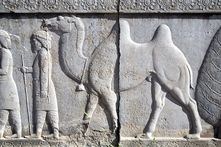 There has been much in the news lately about some new archaeological research that disagrees with the Bible. According to an article on the National Geographic website: Newly published research by two archaeologists at Tel Aviv University in Israel shows that camels weren't domesticated in the eastern Mediterranean until the 10th century B.C.—several centuries after the time they appear in the Bible. The New York Times featured an article on the new research in which they said:
Camels probably had little or no role in the lives of such early Jewish patriarchs as Abraham, Jacob and Joseph, who lived in the first half of the second millennium B.C., and yet stories about them mention these domesticated pack animals more than 20 times ... These anachronisms are telling evidence that the Bible was written or edited long after the events it narrates and is not always reliable as verifiable history. And in an article entitled “Camel bones suggest error in Bible, archaeologists say,” Fox News claimed: Archaeologists from Israel’s top university have used radiocarbon dating to pinpoint the arrival of domestic camels in the Middle East -- and they say the science directly contradicts the Bible’s version of events. Hundreds of similar articles have been featured in news reports across the globe with nearly every one of them claiming that this new study proves the Bible to be wrong. However, all of these reports are ignoring a few very important facts about both the archaeological research and the use of camels in the Bible. What the Bible Says about Camels One of the first things that I do whenever I hear of some archaeological study that disagrees with the Bible is go back to the Bible and read what it actually says. In this particular instance, checking the biblical account is very easy. All I had to do was run a search in my Bible software for every occurrence of the word “camel.” This returned 59 results with 33 of them being accounts that date prior to the dates given by the new study. A quick review of these passages will show us what kind of evidence we should expect archaeologists to find if the Bible is true. The very first references to camels in the Bible is found in Genesis 12:16 where we read of Abraham having camels, and the next 15 references are all to the camels of Abraham. The important thing to remember about the camels of Abraham is that there is no mention of Abraham owning camels before he traveled to Egypt. This would seem to suggest that camels were not readily available in Canaan at this point in time. The next 5 verses mentioning camels are accounts of the camels which were owned by Jacob. The first of these accounts is found in Genesis 30:43 where we read that Jacob “increased exceedingly, and had much … camels.” Now, those who are not familiar with the Bible may think that is only natural for Jacob to have camels since his grandfather brought many of them back with him from Egypt, but the events of Genesis 30 took place after Jacob had fled Canaan. Thus, all the camels of Jacob were obtained while he was in Haran and not in Canaan. It is important to note, however, that Jacob obtained his wealth while working for his uncle, Laban, whose father may have obtained camels from Abraham’s servant as part of the dowry for Rebekah. The final mention of camels in Genesis (37:25) is a reference to a caravan of Ishmeelites who were traveling along a trade route between Egypt and Gilead. Exodus, Leviticus and Deuteronomy each contain one reference to camels. The first, in Exodus 9:3, refers to the camels of Pharaoh. The remaining two simply list the camel among the unclean animals which were not to be eaten by the Jewish people. The next reference to camels in the region of Canaan is found in the account of Gideon in the book of Judges, and this is followed by references in both I Kings and I Chronicles to camels during the reigns of Saul, David and Solomon. This leaves only the book of Job which mentions Job owning camels both before and after his time of tribulation. With this information from the Bible, we can get an idea of what kind of archaeological evidence to expect. During the time period of Job and the patriarchs (2200-1700 BC), the only people mentioned as owning camels in the land of Canaan were individuals who had great wealth and whose travels carried them far outside of that region. During the time of the exodus from Egypt (1446 BC), we are told that Pharaoh owned camels. The southern nations of Canaan were using camels in their military during the time of Gideon’s rebellion (1200 BC), and camels are mentioned as beasts of burden during the reigns of Israel’s first three kings (1050-930 BC). These are the facts about camels that we would expect to be confirmed by archaeological finds. What Archaeology Tells Us about Camels When we turn to the record of archaeology, we find that it fully corroborates the biblical account. For example, a tablet from the Middle Bronze Age (2200-1550) level of Tell Alalakh lists the amount of food that was rationed to be fed to camels. Tell Alalakh is located north of Canaan just below Turkey. This tablet confirms that camels were domesticated in at least one of Canaan’s neighboring regions during the time of the patriarchs. According to a well documented article by Siegfried Horn in the Ministry Journal, there were two pieces of pottery found in Egyptian digs dating to about 2000 BC as well as a camel hair rope from at least 2500 BC and a pottery figure of a camel carrying water jars from 1300 BC. He also mentions two depictions of camels from sites in the region of Canaan which date to the time of the patriarchs. Horn also recounts the discovery of a figurine of a man riding a camel which was found in the region of Ur and which dates to about 2000 BC as well as a seal depicting two men on camels dating from c. 1500 BC and a sculpture of a camel head from 1400 BC. Horn concludes that "the critical scholar pronouncing a Biblical statement as anachronistic for lack of supporting evidence has to modify his statements after every new discovery." So, what about this new article claiming to prove the Bible wrong? Well, when we take the time to actually read the article, we discover that these archaeologists only studied the camel remains in the copper mines of the Aravah Valley. This valley is located near the Gulf of Aqaba. This region is significant in the biblical account of King Solomon for we are told in I Kings 9:26 that Solomon had a navy of ships which sailed from Eziongeber, one of the port cities of the Gulf of Aqaba. All that this new study has shown is that there may not have been any domesticated camels working the mines in this region until the end of Solomon’s reign. This has no bearing at all on the discussion of whether camels were in use in Canaan prior to this time, but it does correlate well with the theory that these mines were the source of the copper used in building Solomon’s temple. Let’s not forget that until a recent discovery, archaeologists denied that these mines were even in use during the time of Solomon. Thus, we see that the biblical account has not been discredited at all by this new discovery. There is a great deal of archaeological evidence which supports the use of the camel in the Middle East from even before the time of the patriarchs. This new evidence merely reminds us of the folly of questioning the record of the Bible; for, prior to 2008, we would have been laughed at for even suggesting that there were copper mines during the time of Solomon. As archaeologists discover more about the events described in the Bible, they are constantly having to adjust their accounts to agree more and more with the record of Scripture.
1 Comment
Sean
2/5/2015 02:48:09 pm
I did not know the validity of the Camels in the bible was challenged again. I found your argument in favor of camels reasonable and based in confirmed archeological evidence. And if new evidence suggests camels were in fact wide spread among the Amorites then there is no "contradiction."
Reply
Your comment will be posted after it is approved.
Leave a Reply. |
Bill Fortenberry is a Christian philosopher and historian in Birmingham, AL. Bill's work has been cited in several legal journals, and he has appeared as a guest on shows including The Dr. Gina Show, The Michael Hart Show, and Real Science Radio.
Contact Us if you would like to schedule Bill to speak to your church, group, or club. "Give instruction to a wise man, and he will be yet wiser: teach a just man, and he will increase in learning." (Proverbs 9:9)
Search
Topics
All
Archives
June 2024
|


 RSS Feed
RSS Feed